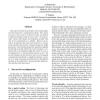Free Online Productivity Tools
i2Speak
i2Symbol
i2OCR
iTex2Img
iWeb2Print
iWeb2Shot
i2Type
iPdf2Split
iPdf2Merge
i2Bopomofo
i2Arabic
i2Style
i2Image
i2PDF
iLatex2Rtf
Sci2ools
CCGRID
2001
IEEE
2001
IEEE
An Adaptive, Reconfigurable Interconnect for Computational Clusters
This paper describes the principles of an original adaptive interconnect for a computational cluster. Torus topology (2d or 3d) is used as a basis but nodes are allowed to effectively migrate along the torus cycles. An optoelectronic scheme which makes such migrations possible with only local synchronisation is outlined. Between the instances of migration the interconnect behaves as a direct packet-routing network which constantly monitors its traffic parameters. A decentralised predictive algorithm is applied periodically to decide whether the current topology is consistent with the predominant traffic flow and if it is not, a reconfiguration to a better-matched topology occurs. We present simulation results that show that on some standard computational benchmarks a significant speedup is possible as a result of automatic matching between the effective topology of the application's message-passing infrastructure and that of the interconnect. 1 The case for reconfiguration In thi...
CCGRID 2001 | Distributed And Parallel Computing | Interconnect | Original Adaptive Interconnect | Topology |
| Added | 23 Aug 2010 |
| Updated | 23 Aug 2010 |
| Type | Conference |
| Year | 2001 |
| Where | CCGRID |
| Authors | Alexander V. Shafarenko, Vladimir Vasekin |
Comments (0)

